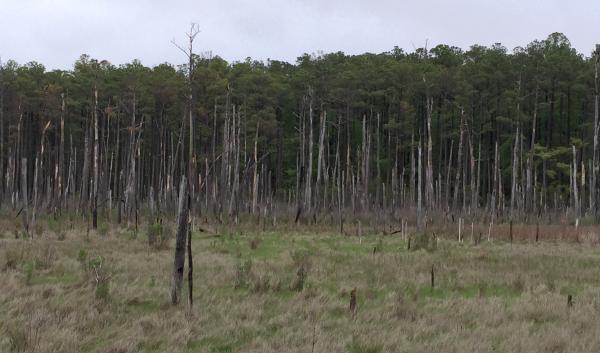Leer en español: Impactos del cambio climático en los bosques costeros
Rising sea levels and intense storms along the mid-Atlantic and southern New England coast are damaging and killing coastal forests.
Studies document signs of stress and dieback, resulting in “ghost forests”. These are areas of standing dead trees that merge into tidal marshes. Although sea-levels have varied for thousands of years, the threat to coastal forests appear to be increasing as rates of sea level rise accelerate. A recent review of the scientific literature and interviews with leading experts suggest that there are two important mechanisms driving coastal forest dieback. Sea-level rise causes changes in the groundwater table in concert with increased saltwater inundation from storm surges and exceptionally high tides (king tide flooding). Rising groundwater tables can lead to saturated soils in low lying coastal forest areas, especially during periods of high rainfall. High groundwater levels limit root oxygen, stressing vegetation and limiting regeneration. Periodic saltwater inundation of the forests from very high tides and storm surges create saline conditions in the soil and in the shallow groundwater. These events may then exceed the existing trees’ salinity or saturation tolerances, leading to a wave of tree death and leaving the site inhospitable to regrowth. Accelerated sea-level rise is expected to make both factors more frequent.
The baseline for coastal flooding rises as sea level rises. This brings further inland daily and monthly tidal flooding, periodic storm surges, and the fresh/saline transition zone in shallow groundwater. Over time, the further inland reach of storm surges results in coastal forest dieback (referred to as ghost forests because of still standing dead trees). Rising sea levels also raise the water table tens to hundreds of meters inland from tidal water, resulting in a thinner aerated zone and the water table closer to the ground surface. The resulting water-saturated soils stress existing vegetation and can ultimately convert forested wetlands to standing-water wetlands with accompanying forest dieback. Not shown but also important: near-shore, low-lying freshwater wetlands become brackish as storm surges reach farther inland and the shorter interval between storm surges results in less dilution between events by precipitation and groundwater flow. Note: drawing not to scale. (Graphic credit: Karrah Kwasnik, US Department of Agriculture; Glen Carleton, US Geological Survey; Richard Lathrop, Marjorie Kaplan, and Rachael Sacatelli, Rutgers University).

Why does it matter?
Coastal forests in the mid-Atlantic and southern New England are a mix of hardwoods and evergreen trees. They provide habitat for an array of rare plants and wildlife, store carbon, and are valuable as timber resources. Together with adjacent salt marshes, coastal forests also help buffer inland areas from coastal storms.
How can we help coastal forests adapt to rising sea-level?
Certain species are more tolerant to salty or flooded soils. Managing existing coastal forest vegetation through revegetation with more tolerant species may be an option for some areas. Strategic land conservation and restoration of adjacent areas can help coastal forest migration inland. Since coastal forests are very closely linked to their adjacent tidal marshes, it is important to align management objectives considering Climate Change Impacts to Coastal Forests both systems together. Marsh management techniques may benefit coastal forests. Employing tactics such as creating living shorelines, depositing dredge sediments, and increasing drainage in ponded marsh interiors slow down sea-level rise impacts. Ditches, dikes, barriers or other engineered infrastructure can be used to manage the water in order to maintain a coastal forest community. These need to be evaluated carefully and might prove costly.
What research is needed?
The reasons for coastal forest dieback vary by location. Rising groundwater tables and saltwater flooding, either singly or in combination, are the main causes. Better understanding these factors is key to determining whether slowing the loss of coastal forest at a site is even feasible. In many cases it may not be possible to prevent further forest dieback. If feasible, what might be the most appropriate cost-effective approaches? In some locations, marshes are ditched for mosquito control or agricultural purposes. These ditches improve drainage but provide pathways for salt water to reach adjacent coastal forests. Engineering solutions such as modification of the ditching and/or installation of tide gates to slow saltwater inundation may make sense in specific instances. In other locations, adaptive management of the forest themselves may be the best recourse. Further research is needed on how to manage these forests as they undergo stress, how to reduce competition from the invasive plant species Phragmites australis (common reed) and how to enhance tree and shrub regeneration. The research could inform possible restoration and management options. To fully grasp the geographic scope of ghost forests, region-wide mapping and modeling are needed. This will highlight the spatial extent of historic forest dieback and projected future hotspots.
Research brief Full report


